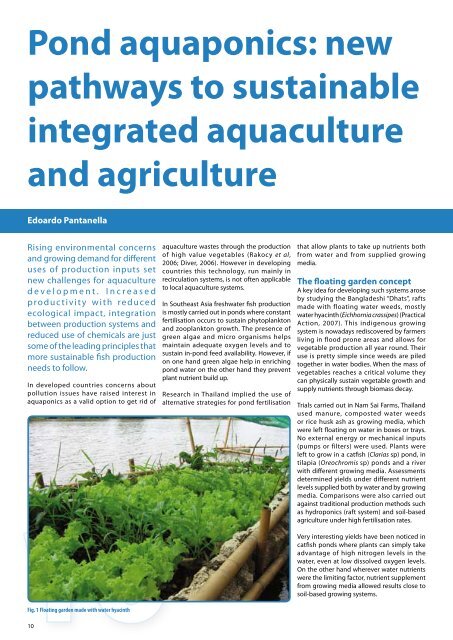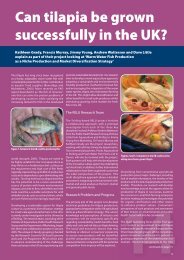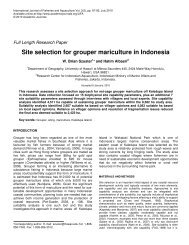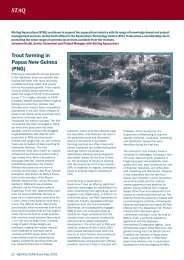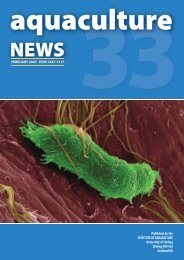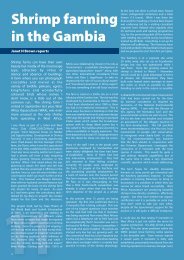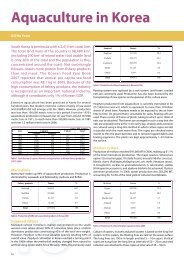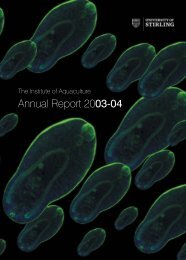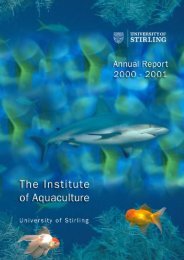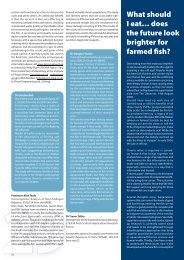Pond aquaponics: new pathways to sustainable integrated ...
Pond aquaponics: new pathways to sustainable integrated ...
Pond aquaponics: new pathways to sustainable integrated ...
Create successful ePaper yourself
Turn your PDF publications into a flip-book with our unique Google optimized e-Paper software.
<strong>Pond</strong> <strong>aquaponics</strong>: <strong>new</strong><strong>pathways</strong> <strong>to</strong> <strong>sustainable</strong><strong>integrated</strong> aquacultureand agricultureEdoardo PantanellaRising environmental concernsand growing demand for differentuses of production inputs set<strong>new</strong> challenges for aquacultured e v e l o p m e n t . I n c r e a s e dp r o d u c t i v i t y w i t h r e d u c e decological impact, integrationbetween production systems andreduced use of chemicals are justsome of the leading principles thatmore <strong>sustainable</strong> fish productionneeds <strong>to</strong> follow.In developed countries concerns aboutpollution issues have raised interest in<strong>aquaponics</strong> as a valid option <strong>to</strong> get rid of1010Fig. 1 Floating garden made with water hyacinthaquaculture wastes through the productionof high value vegetables (Rakocy et al,2006; Diver, 2006). However in developingcountries this technology, run mainly inrecirculation systems, is not often applicable<strong>to</strong> local aquaculture systems.In Southeast Asia freshwater fish productionis mostly carried out in ponds where constantfertilisation occurs <strong>to</strong> sustain phy<strong>to</strong>plank<strong>to</strong>nand zooplank<strong>to</strong>n growth. The presence ofgreen algae and micro organisms helpsmaintain adequate oxygen levels and <strong>to</strong>sustain in-pond feed availability. However, ifon one hand green algae help in enrichingpond water on the other hand they preventplant nutrient build up.Research in Thailand implied the use ofalternative strategies for pond fertilisationthat allow plants <strong>to</strong> take up nutrients bothfrom water and from supplied growingmedia.The floating garden conceptA key idea for developing such systems aroseby studying the Bangladeshi “Dhats”, raftsmade with floating water weeds, mostlywater hyacinth (Eichhornia crassipes) (PracticalAction, 2007). This indigenous growingsystem is nowadays rediscovered by farmersliving in flood prone areas and allows forvegetable production all year round. Theiruse is pretty simple since weeds are piled<strong>to</strong>gether in water bodies. When the mass ofvegetables reaches a critical volume theycan physically sustain vegetable growth andsupply nutrients through biomass decay.Trials carried out in Nam Sai Farms, Thailandused manure, composted water weedsor rice husk ash as growing media, whichwere left floating on water in boxes or trays.No external energy or mechanical inputs(pumps or filters) were used. Plants wereleft <strong>to</strong> grow in a catfish (Clarias sp) pond, intilapia (Oreochromis sp) ponds and a riverwith different growing media. Assessmentsdetermined yields under different nutrientlevels supplied both by water and by growingmedia. Comparisons were also carried outagainst traditional production methods suchas hydroponics (raft system) and soil-basedagriculture under high fertilisation rates.Very interesting yields have been noticed incatfish ponds where plants can simply takeadvantage of high nitrogen levels in thewater, even at low dissolved oxygen levels.On the other hand wherever water nutrientswere the limiting fac<strong>to</strong>r, nutrient supplementfrom growing media allowed results close <strong>to</strong>soil-based growing systems.
Fig. 2 Trials in catfish farmAdvantages in <strong>integrated</strong>productionHigher revenues can be achieved byfarmers who can increase farm productivityand differentiate production with limitedinvestment. Free availability of water weedsguarantees cheap supplies and keepschannels clear of clogging vegetation, thusproviding an important environmentalservice. Decaying organic material can helpfertilise ponds and at the same time providea plant growing environment less prone<strong>to</strong> diseases and <strong>to</strong> soil pests. Reductionof chemical inputs allows farmers <strong>to</strong> getpremium prices from soilless (hydroponic)or organic vegetables in a market quitesensitive <strong>to</strong> pesticide use in agriculture.Surveys carried out in the Bangkok areasuggest that nearly all the vegetables sold insupermarkets (conventional, hydroponic ororganic), show some degree of certificationand traceability. In addition hydroponic andorganic product prices are 100-600% higherthan those of conventional agriculture (from0.75-1.1 €/kg for conventional up <strong>to</strong> 4-7.6 €/kg for hydroponics and organic lettuce).Future perspectivesSimplicity in design and managementwith almost no energy and low equipmentcosts makes these systems an interestingsolution wherever land availability, flooding,productivity and ecological footprint are anissue. In addition the use of water weeds asa resource can indeed increase livelihoodsopportunities in all those areas affectedworldwide.Further research needs <strong>to</strong> address the nutrientdynamics of different growing media and<strong>to</strong> optimise system design and nutritionalrequirement of vegetables in those waterbodies with limited dissolved nutrients. Thepossibilities of this <strong>integrated</strong> system arequite high and can provide sensitive benefits<strong>to</strong> smallholders as well as big aquacultureenterprises.The potential of these systems is howevernot fully acknowledged and interdisciplinarylinks and research can undoubtedly addressmany of the issues that are still unattended.ReferencesDiver S, 2006. Aquaponics—Integration of Hydroponicswith Aquaculture (Internet). ATTRA - National SustainableAgriculture Information Service. Available from: (accessedon 02/4/2008)Practical Action (2007) Floating Gardens in Bangladesh(Internet). The Schumacher Centre for Technology &Development. Available from: (accessed on 02/4/2008)Rakocy, J.E., Masser, M.P. and Losordo, T.M. (2006)Recirculating Aquaculture Tank Production Systems:Aquaponics-Integrating Fish and Plant Culture (Internet)SRAC Publication No. 454 (revision November 2006)Department of Agriculture, USA. Available from: < http://srac.tamu.edu/tmppdfs/1251841-srac454.pdf?cfid=1251841&cf<strong>to</strong>ken=a3bfa0221a4d437c-1867122a-7e93-35cb-88db9c0db730c1de&jsessionid=8e304aae606019523c1d >(accessed on 03/4/2008)Fig. 3 Water weeds in tropical areas can easily double their biomass in just a few days11Aquaculture News 34 / May 2008 11Fig. 4 Growth comparison for romaine lettuce. A on raftmade with water hyacinth; B on ash pots in a catfish farm;C on ash with zero nutrients (control); D on soil with full useof fertilizer


